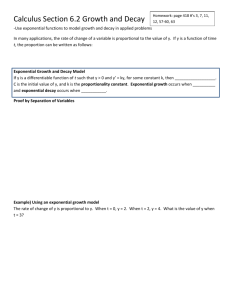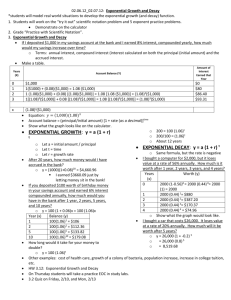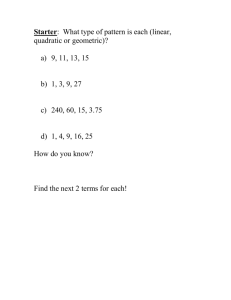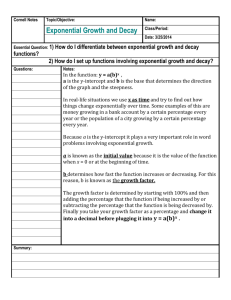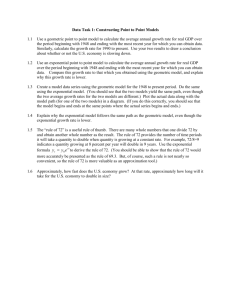Unit 3 Mid-Unit Assessment Study Guide Name
advertisement
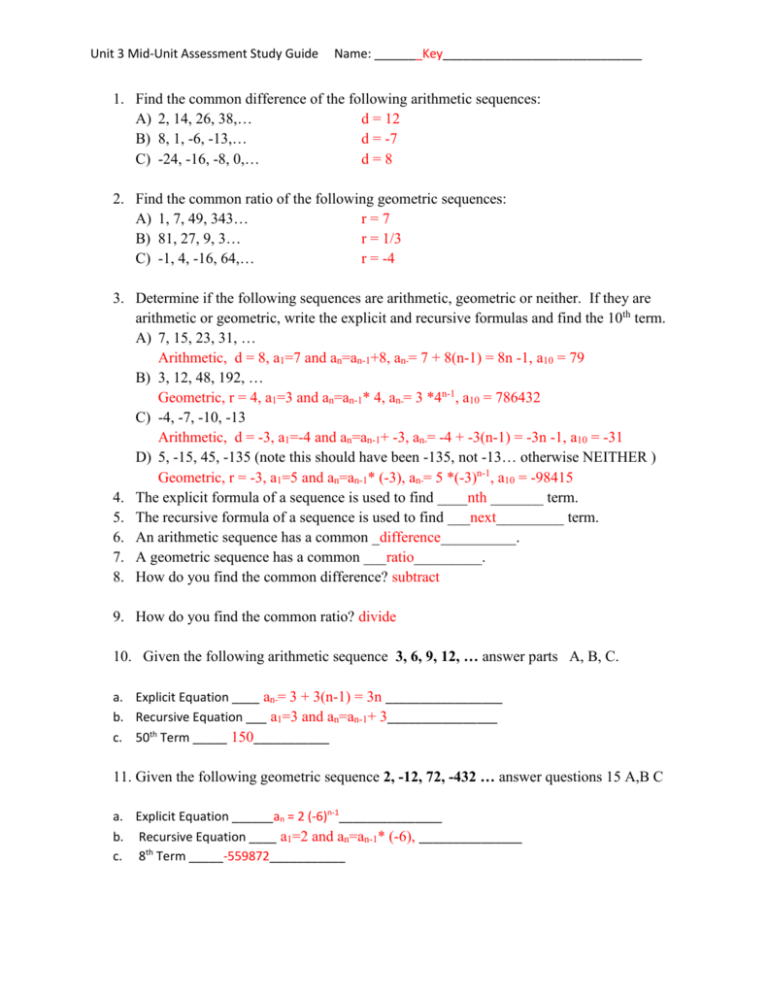
Unit 3 Mid-Unit Assessment Study Guide Name: _______Key_____________________________ 1. Find the common difference of the following arithmetic sequences: A) 2, 14, 26, 38,… d = 12 B) 8, 1, -6, -13,… d = -7 C) -24, -16, -8, 0,… d=8 2. Find the common ratio of the following geometric sequences: A) 1, 7, 49, 343… r=7 B) 81, 27, 9, 3… r = 1/3 C) -1, 4, -16, 64,… r = -4 3. Determine if the following sequences are arithmetic, geometric or neither. If they are arithmetic or geometric, write the explicit and recursive formulas and find the 10th term. A) 7, 15, 23, 31, … Arithmetic, d = 8, a1=7 and an=an-1+8, an = 7 + 8(n-1) = 8n -1, a10 = 79 B) 3, 12, 48, 192, … Geometric, r = 4, a1=3 and an=an-1* 4, an = 3 *4n-1, a10 = 786432 C) -4, -7, -10, -13 Arithmetic, d = -3, a1=-4 and an=an-1+ -3, an = -4 + -3(n-1) = -3n -1, a10 = -31 D) 5, -15, 45, -135 (note this should have been -135, not -13… otherwise NEITHER ) Geometric, r = -3, a1=5 and an=an-1* (-3), an = 5 *(-3)n-1, a10 = -98415 4. The explicit formula of a sequence is used to find ____nth _______ term. 5. The recursive formula of a sequence is used to find ___next_________ term. 6. An arithmetic sequence has a common _difference__________. 7. A geometric sequence has a common ___ratio_________. 8. How do you find the common difference? subtract 9. How do you find the common ratio? divide 10. Given the following arithmetic sequence 3, 6, 9, 12, … answer parts A, B, C. a. Explicit Equation ____ an = 3 + 3(n-1) = 3n _________________ b. Recursive Equation ___ a1=3 and an=an-1+ 3________________ c. 50th Term _____ 150___________ 11. Given the following geometric sequence 2, -12, 72, -432 … answer questions 15 A,B C a. Explicit Equation ______an = 2 (-6)n-1_______________ b. Recursive Equation ____ a1=2 and an=an-1* (-6), _______________ c. 8th Term _____-559872___________ Unit 3 Mid-Unit Assessment Study Guide Name: _______Key_____________________________ 12. Identify each function as an exponential growth function or an exponential decay function: a. y = 2(1.25)x Growth x b. f(x) = 1.5(.75) Decay 2 c. y = 3( 3 )x Decay d. g(x) = 2500( 7 x ) 5 Growth 13. In the exponential function given below, identify the initial amount and the growth rate. y = 250(1 + 0.2)t y =250 (1.20)t Note: 1+ .2 is 1.20, not 1.02… so 1.20 = 120% Time starts at 0 so (0, 250) so initial amount is 250, growth increasing by 20% 14. Write an exponential growth function to model the situation. A population of 422,000 increases by 12% each year. y = 422000 (1.12)t note: 100% + 12% is 112% = 1.12 growth factor 15. Write an exponential growth function to model the situation. You start with $30,000 and earn 15% interest each year. How much do you have after 25 years? y = 30000 (1.15)t y = 30000(1.15)25 = $ 987568.58 (money so round) 16. A car bought for $13,000 depreciates at 12% per annum (means per year). What is its value after 7 years? y = 13000 (0.88)t since 100% - 12% = 88% = .88 y = 13000(0.88)7 = $5312.78 17. Does the equation y = 11(1.11)x model exponential growth or exponential decay? Find the growth or decay factor and the percent change per time period. Exponential Growth, growth factor 1.11, growth rate 0.11 = 11% (increasing by 11% per time period) 18. Does the equation y = 27(3/2) x model exponential growth or exponential decay? Find the growth or decay factor and the percent change per time period. 3/2 = 1.5 = 1.50 = 150% = 100% + 50% growth Exponential Growth, growth factor 1.50 (or 1.5), growth rate .50 = 50% (increasing by 50% per time period) Unit 3 Mid-Unit Assessment Study Guide Name: _______Key_____________________________ 19. Does the equation y = 7(3/4) t model exponential growth or exponential decay? Find the growth or decay factor and the percent change per time period. ¾ = 0.75 = 75% = 100% - 25% decay Exponential Decay, decay factor 0.75 (or 3/4), decay rate 0.25 = 25% (decreasing by 25% per time period)





